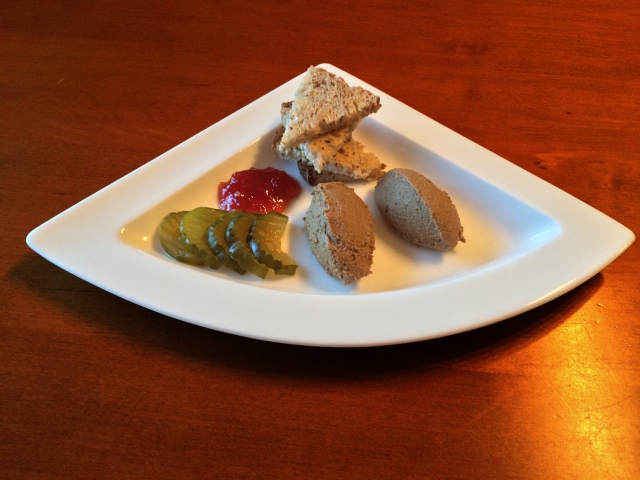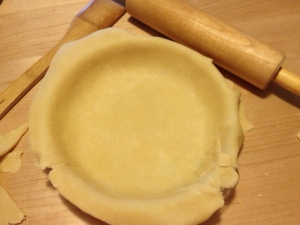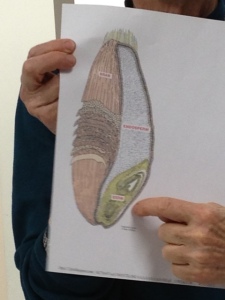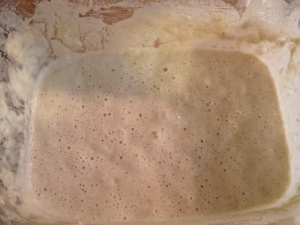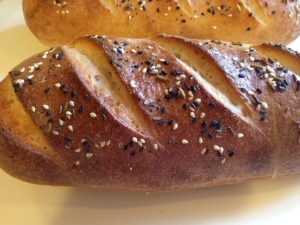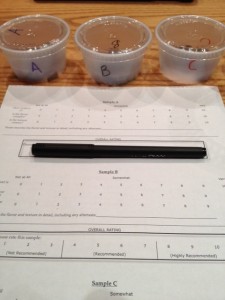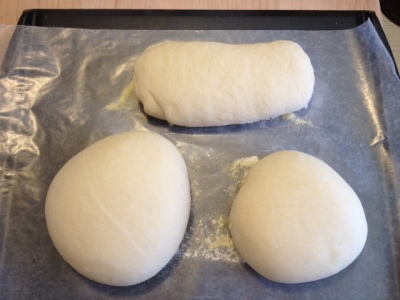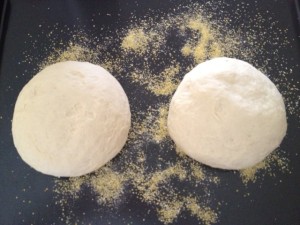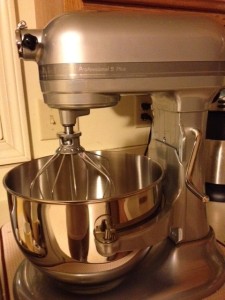My first baking experiment wasn’t exactly a failure, but it certainly didn’t yield the kind of results I was hoping for. At the end of the day, I concluded quite accurately that I just didn’t know enough about baking to know what to look for. I need more education and experience to really understand what the baking process means at the molecular level. Therefore, for my second experiment, I decided to take my brother Alan’s advice and go back to basics.
I chose plain jane, everyday, run-of-the-mill white bread as my second baking project. And I chose Julia’s basic recipe from her companion book “Baking with Julia” as a place to start. My plan was to follow her recipe explicitly, leave no steps out, be precise and resist the urge to jack things up like I normally do. I also thought it was a good idea to manage my own expectations. It’s white bread, so the final product is supposed to have a fluffy crumb and a thin crust. Knowing how this bread was supposed to turn out gave me a specific goal to shoot for.
This recipe is painfully simple. It calls for approximately 7 cups of flour, 1 tbsp of active dry yeast, 1 tbsp of sugar, 2 1/2 cups of water, 1 tbsp of salt and half a stick of butter mixed in at the end of the kneading process. I should also say that in my last blog, I didn’t talk about the kind of flour I used. All the bread recipes I’ve seen call for bread flour or all purpose flour. Bread flour has more gluten in it, which is optimum for making bread. I have committed myself to using King Arthur bread flour exclusively for all these recipes. King Arthur makes superior products and their flour is highly regarded by many bakers. Even better, the company is headquartered in Norwich, Vermont, just an hour away from my home, making this a locally produced product.
I took this baking project very seriously. I measured everything out in advance so that I would not be distracted when I started working with the dough. I made sure I had the right kind of yeast, active dry yeast. To bloom the yeast, the recipe called for the water to be between 105 and 115 degrees. In my last baking project, which called for warm water, I guessed at the water temperature. And I’m not completely certain that my yeast ever bloomed properly. But this time I used my meat thermometer to make sure the water was exactly 110 degrees. I put the dry active yeast in the bowl of my stand mixer with the exact amount of sugar and exact amount of 110 degree water and whisked it just to combine everything. Then I watched. My reward came after about five minutes. When the recipes call for yeast to “bloom”, I had no idea what that meant, until I witnessed the process myself. I saw the yeast bloom. From what looked like a little pool of wet cornmeal in the bottom of the bowl, a frothy, living substance puffed info life right before my eyes. I felt like I was watching a birth and in that moment, I understood what the chemistry is that makes bread do its thing. Yeast is alive!! And it was doing the macarena in my mixing bowl.
I followed Julia’s recipe and poured the rest of the water in the bowl. In my first baking project, I dumped all the flour into the water and turned on the mixer. The dough ended up very dry and I had to add a little more water to coax it to come together.  This time, I added three cups of the flour first and started the mixer very slowly to make sure it was all combined before adding any more flour. Once the flour was all mixed into the water, I started adding more flour half a cup at a time until the dough started coming together. At the point where the dough formed a tight ball, I stopped adding flour. And in the end, it took a little over 6 1/2 cups. So, when Julia said “approximately” in her recipe, this is what she meant. I turned up the mixer and started the kneading. And from all the advice I’d been given, this dough was doing exactly what it was supposed to do. Periodically, it climbed up the dough hook and I had to stop the mixer and manipulate the dough a little bit to rearrange its position in the bowl.
This time, I added three cups of the flour first and started the mixer very slowly to make sure it was all combined before adding any more flour. Once the flour was all mixed into the water, I started adding more flour half a cup at a time until the dough started coming together. At the point where the dough formed a tight ball, I stopped adding flour. And in the end, it took a little over 6 1/2 cups. So, when Julia said “approximately” in her recipe, this is what she meant. I turned up the mixer and started the kneading. And from all the advice I’d been given, this dough was doing exactly what it was supposed to do. Periodically, it climbed up the dough hook and I had to stop the mixer and manipulate the dough a little bit to rearrange its position in the bowl.
After 10 minutes of kneading, the recipe called for adding the room temperature butter. Julia warned me that the dough would turn ugly, look like it was falling apart and that it might appear the butter wasn’t going to mix in, but after a few minutes it would all come together. That’s exactly what happened to me. When I turned the mixer up a notch, the butter incorporated perfectly. The finished dough from my first baking project was kind of stiff and lumpy. But this dough was soft, fluffy and smooth. My father described good bread dough as having the feel of a baby’s bottom. I don’t have any babies, so I have to guess at what their butts feel like. Perhaps I should say that a baby’s butt is supposed to feel like perfect bread dough.
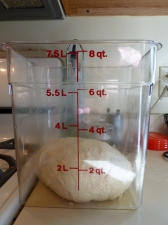 I rolled my dough into a smooth ball by bunching up the bottom and pinching it together. Then I placed it into my lightly oiled plastic bin, rolled the dough around to make sure it had a light sheen of oil all over the surface, covered the bin with cling film and set it on my stovetop for its first rise. All the bread recipes I’ve seen suggest a warm place for the dough to rise. I had my oven set at 170 degrees to create a warm spot toward the back of my stovetop. That’s where the dough sat….for a ninety minute rise. I walked away, but the dough never left my mind. I was started to obsess a little bit.
I rolled my dough into a smooth ball by bunching up the bottom and pinching it together. Then I placed it into my lightly oiled plastic bin, rolled the dough around to make sure it had a light sheen of oil all over the surface, covered the bin with cling film and set it on my stovetop for its first rise. All the bread recipes I’ve seen suggest a warm place for the dough to rise. I had my oven set at 170 degrees to create a warm spot toward the back of my stovetop. That’s where the dough sat….for a ninety minute rise. I walked away, but the dough never left my mind. I was started to obsess a little bit.
 When I came back and hour later, the transformation was well under way. My dough was huge!! It needed another half an hour, but I could hardly contain my excitement. I sat at the dining room table for the next thirty minutes, clicking my fingernails on the table and watching the clock….tick, tick, tick….click, click, click…..tick, tick, tick…..rise, rise, rise. When I turned the dough out of the container onto my floured countertop after exactly ninety minutes, it was beautiful. It was soft and a little sticky, pliable but firm and when I patted it lovingly, it had kind of a pleasant hollow sound. This had to be right; I knew it in my bones. I cut the dough in half and following Julia’s directions, patted each half into a thin rectangle measuring about 9 x 12 inches. I folded each rectangle like I was folding a business letter, one end to the center and the other end over the top, pinching it together at the seam.
When I came back and hour later, the transformation was well under way. My dough was huge!! It needed another half an hour, but I could hardly contain my excitement. I sat at the dining room table for the next thirty minutes, clicking my fingernails on the table and watching the clock….tick, tick, tick….click, click, click…..tick, tick, tick…..rise, rise, rise. When I turned the dough out of the container onto my floured countertop after exactly ninety minutes, it was beautiful. It was soft and a little sticky, pliable but firm and when I patted it lovingly, it had kind of a pleasant hollow sound. This had to be right; I knew it in my bones. I cut the dough in half and following Julia’s directions, patted each half into a thin rectangle measuring about 9 x 12 inches. I folded each rectangle like I was folding a business letter, one end to the center and the other end over the top, pinching it together at the seam.  Each rectangle fit perfectly into my 8 1/2 x 4 1/2 loaf pans, with the seams on the bottom. I covered each one with a lightly oiled piece of cling wrap and set them on the stovetop for their second rise of forty-five minutes.
Each rectangle fit perfectly into my 8 1/2 x 4 1/2 loaf pans, with the seams on the bottom. I covered each one with a lightly oiled piece of cling wrap and set them on the stovetop for their second rise of forty-five minutes.
This time I was more patient and didn’t hover around the kitchen waiting for something to happen. I turned the oven up to 375 degrees and I walked away, I went downstairs and watched TV and folded laundry and did my Sunday chores.  And when I came back forty five minutes later, my loaves looked perfect. According to Julia’s description, the dough should have risen over the tops of the loaf pans. That’s what mine had done. The oven was now hot and the dough was ready to bake and I was just forty minutes away from knowing if my hard work had paid off. I splashed a little water on the inside of my oven for good measure and put the bread in. This was when my patience really gave out. I had to force myself to leave the kitchen rather than sitting on the floor in front of the oven door to watch the bread bake. Luckily, the phone rang and a long conversation with my in-laws was the perfect distraction to keep me away from the kitchen. When we were talking on the phone, I started smelling that freshly baked aroma, the smell that signals home and hearth.
And when I came back forty five minutes later, my loaves looked perfect. According to Julia’s description, the dough should have risen over the tops of the loaf pans. That’s what mine had done. The oven was now hot and the dough was ready to bake and I was just forty minutes away from knowing if my hard work had paid off. I splashed a little water on the inside of my oven for good measure and put the bread in. This was when my patience really gave out. I had to force myself to leave the kitchen rather than sitting on the floor in front of the oven door to watch the bread bake. Luckily, the phone rang and a long conversation with my in-laws was the perfect distraction to keep me away from the kitchen. When we were talking on the phone, I started smelling that freshly baked aroma, the smell that signals home and hearth.  And by the time we hung up the phone, my bread was baked and the entire house was filled with the intoxicating warm perfume of a bakery. My bread was baked and it was a sight to behold, tall and proud rising above the sides of the pan with a perfect golden-brown crust.
And by the time we hung up the phone, my bread was baked and the entire house was filled with the intoxicating warm perfume of a bakery. My bread was baked and it was a sight to behold, tall and proud rising above the sides of the pan with a perfect golden-brown crust.
My plan was to use my fresh bread to make club sandwiches. While the bread was cooling, I sliced the turkey breast an tomato, cooked the bacon and washed the lettuce. When I sliced into the first loaf, my heart leapt with joy. SUCCESS!! The bread was fluffy and buttery and delicious and turned out exactly as I’d expected. I’m moving forward with this baking project with a renewed sense of confidence, armed with a little more experience and understanding. What’s next? I’m not sure, but at least now I know how to make a basic loaf of bread.


